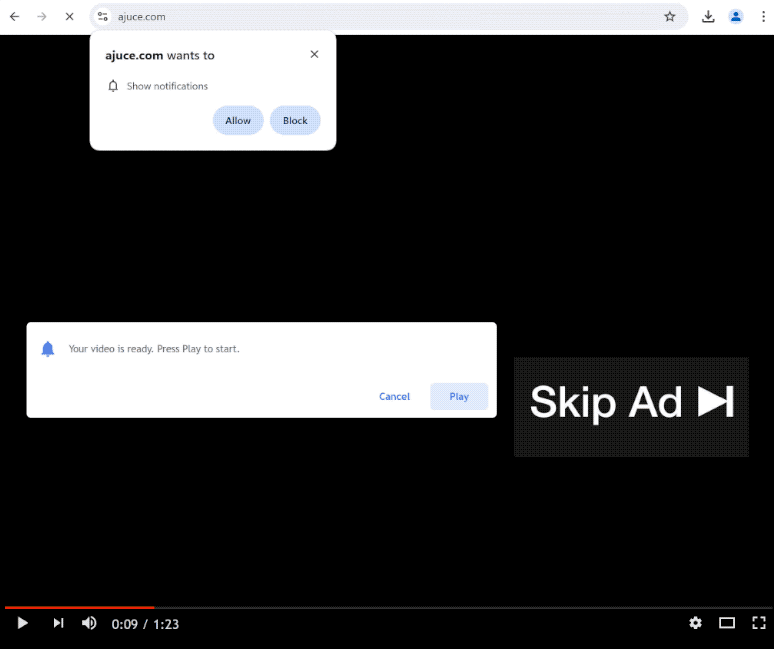ajuce.com is a deceptive website that tries to trick users into allowing ads on their desktops. When you get redirected to the site, you will immediately get a browser alert saying “ajuce.com wants to show notifications”. If you click “Allow”, you will authorize the site to spam ads.
When you get redirected to ajuce.com, your browser will display a prompt asking you to permit ajuce.com to show notifications. While this “show notifications” feature is a legitimate one, plenty of websites abuse it to spam ads on users’ desktops. As is the case with ajuce.com. These ads may look like system notifications and appear in a similar place, which could trick users into interacting with them. If you have already granted permission, it’s important not to engage with the notifications, as they could lead to exposure to harmful content such as scams and malware.
If you have given ajuce.com permission to show notifications, the sooner you revoke it, the better. You can do it in your browser settings. If you need help navigating your browser’s settings, instructions are available at the end of this report.
Why are you redirected to sites like ajuce.com?
There are various reasons why you might be redirected to sites like ajuce.com. In rare cases, these redirects are caused by adware, but such an infection is usually accompanied by other symptoms. Typically, users are redirected when visiting high-risk websites that try to bombard them with as many ads as possible to generate revenue. Sites with pirated or pornographic content are especially notorious for this as clicking on anything on these sites will likely trigger a redirect. However, both regular ads and random redirects can be blocked by any decent adblocker program.
Additionally, redirects to ajuce.com can also indicate an adware infection. Adware, browser hijackers, and similar infections are often unintentionally installed by users through what’s known as the software bundling method. Adware is often added to popular free programs as extra offers and set to be installed alongside the programs automatically without requiring explicit permission from users.
It’s important to be aware that additional offers that come with free software installations are always optional and their installations can be prevented. However, users need to manually deselect them in order to prevent their installations. These added offers are hidden in settings that users don’t typically use, making them easy to miss. Software bundling is a deceptive installation method, and programs that use it are often flagged as potential threats by anti-virus programs.
To avoid these unwanted installations, pay close attention when installing free programs. When given the option, choose Advanced (Custom) settings instead of Default (Basic) during installation. While the installation window may recommend using Default settings, doing so will authorize all added offers to install alongside the main program. On the other hand, Advanced or Custom settings will clearly display all added offers, allowing you to deselect anything you don’t want. Even if these offers initially seem useful, it’s best not to allow them to be installed. Failing to be cautious during free program installations can result in your computer being filled with junk like adware.
How to stop ajuce.com notifications?
Make sure to scan your computer with an anti-virus program to check for any adware as the redirects may be triggered by an infection. Adware can also be persistent and difficult to remove manually, so it’s best to use an anti-virus program. Additionally, you need an adblocker program to block not only the redirects but also regular ads.
If you have given permission to ajuce.com to show you notifications, you can easily revoke this permission in your browser’s settings. Follow the instructions below if you need assistance. Review all the sites that have permission to show notifications, and remove ajuce.com and any others that you do not recognize. If you don’t plan to use this feature, you can also turn off notification requests altogether.
If you have given the site permission to show notifications, here’s how to revoke it:
- Mozilla Firefox: Open the menu (the three bars at the top-right corner), click Options, then Privacy & Security. Scroll down to Permissions, press Settings next to Notifications, and remove ajuce.com and any other questionable websites from the list. It’s possible to permanently turn off push notification requests by checking the “Block new requests asking to allow notifications” box in the same Notifications settings.
- Google Chrome: Open the menu (the three dots top-right corner), then Settings, then Privacy and security, then Site Settings. Click on Notifications under Permissions, and remove ajuce.com and any other questionable websites from the list. It’s possible to permanently turn off push notification requests by toggling off “Sites can ask to send notifications”.
- Microsoft Edge: Open the menu (the three dots top-right corner), then Settings, then Cookies and site permissions, then Notifications. Review which sites have permission and remove ajuce.com and any other questionable websites from the list. It’s possible to permanently turn off push notification requests by toggling off “Ask before sending”.
Site Disclaimer
2-remove-virus.com is not sponsored, owned, affiliated, or linked to malware developers or distributors that are referenced in this article. The article does not promote or endorse any type of malware. We aim at providing useful information that will help computer users to detect and eliminate the unwanted malicious programs from their computers. This can be done manually by following the instructions presented in the article or automatically by implementing the suggested anti-malware tools.
The article is only meant to be used for educational purposes. If you follow the instructions given in the article, you agree to be contracted by the disclaimer. We do not guarantee that the artcile will present you with a solution that removes the malign threats completely. Malware changes constantly, which is why, in some cases, it may be difficult to clean the computer fully by using only the manual removal instructions.
